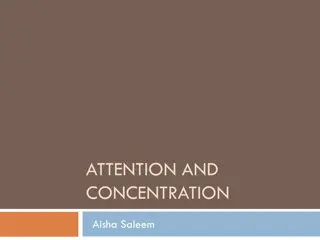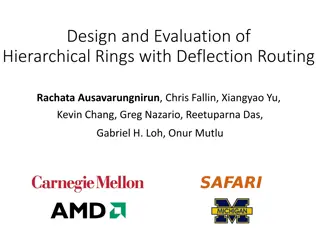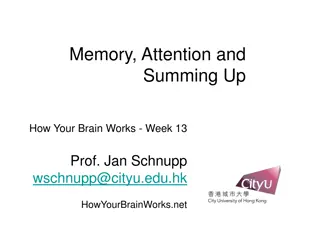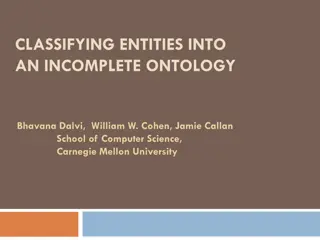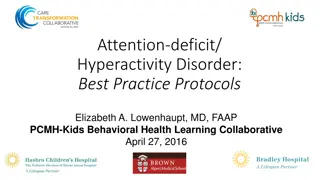Prioritizing Clinically Important Outcomes Using Hierarchical Win Ratio
Clinical trials often use composite outcomes, but conventional analysis methods have limitations in accurately reflecting clinical reality. Hierarchical outcomes offer flexibility by defining a hierarchy of events based on importance. Analyzing trials using hierarchical outcomes involves comparing p
7 views • 20 slides
Understanding Attention Deficit Hyperactivity Disorder (ADHD)
ADHD is a common neurodevelopmental disorder affecting attention, activity levels, and impulse control. It manifests in different subtypes and can be spotted in children before the age of 6. Symptoms persist across contexts and should cause impairment in social, academic, or occupational areas. Gene
0 views • 39 slides
Why Starting with Cinema is Crucial for a Successful New Product Launch
Launching a new product in today's media landscape can be challenging, with fragmented audiences and intense competition for attention. Starting with cinema in your audiovisual mix can be highly effective in maximizing reach, attention, and trust for your brand. Cinema offers unparalleled levels of
2 views • 11 slides
Understanding Set Transformer: A Framework for Attention-Based Permutation-Invariant Neural Networks
Explore the Set Transformer framework that introduces advanced methods for handling set-input problems and achieving permutation invariance in neural networks. The framework utilizes self-attention mechanisms and pooling architectures to encode features and transform sets efficiently, offering insig
9 views • 21 slides
ANTECEDENT STRATEGIES
Learn about antecedent strategies presented by Eileen Webster, BCBA, including what antecedents are and how they can help decrease problem behaviors. Discover the importance of positive attention, predictable schedules, praising behavior, and effective pairing techniques in managing classroom behavi
1 views • 19 slides
Understanding Multi-Head Attention Layers in Transformers
Sitan Chen from Harvard presents joint work with Yuanzhi Li exploring the provable learnability of a multi-head attention layer in transformers. The talk delves into the architecture of transformers, highlighting the gap between practical success and theoretical understanding. Preliminaries, prior w
3 views • 38 slides
Understanding Clustering Algorithms: K-means and Hierarchical Clustering
Explore the concepts of clustering and retrieval in machine learning, focusing on K-means and Hierarchical Clustering algorithms. Learn how clustering assigns labels to data points based on similarities, facilitates data organization without labels, and enables trend discovery and predictions throug
1 views • 48 slides
Looking for Courtyard construction in Plimmerton?
Looking for Courtyard construction in Plimmerton? Welcome to Lexus Landscaping in Camborne - Wellington's exclusive landscape design specialists. A boutique landscape design and construction company who only work on one job at a time to ensure you get the best of our attention at all times. Personal
0 views • 6 slides
Mastering the Art of Writing a Standout Cover Letter
Crafting a compelling cover letter is essential to capturing an employer's attention and securing an interview. Learn the key components - attention-grabbing introduction, showcasing qualifications and achievements, and a strong call to action. Follow these tips to create a personalized, impactful c
2 views • 11 slides
Crafting a Strong Cover Letter: Attention to Detail and Tailored Content
Crafting a compelling cover letter requires attention to detail to ensure the address and phone number are correct, language and formatting are precise, and content is tailored to showcase relevant skills and experiences. Employers seek a clear demonstration of how your background aligns with their
0 views • 4 slides
Strategic Creativity in Tourism Business: Unleashing Innovation and Growth
Explore the dynamic landscape of strategic creativity in tourism business through the lens of the experience and attention economy. Discover how creativity-based approaches can reshape planning and generate novel opportunities in the tourism sector. Delve into the concepts of the experience economy,
5 views • 14 slides
Understanding Attention and Concentration: Key Aspects and Determinants
Attention is our ability to focus on specific stimuli while disregarding distractions. It can be categorized into focused, sustained, divided, and alternating attention. External and internal factors influence our attention levels. The nature of stimuli plays a crucial role in capturing attention ef
0 views • 19 slides
Hyaluronic Acid for Acne-Prone Skin Benefits and Tips
Acne-prone skin requires special care and attention to maintain its health and appearance. One ingredient that has garnered significant attention in the skincare community is hyaluronic acid. Known for its exceptional hydrating properties, hyaluronic
0 views • 5 slides
Exploring Attention and Relevance in English PhD Research
Delve into the dynamics of attention and relevance within English research through a comprehensive and structured exploration. Uncover the impact, originality, and unique value of your study amidst existing literature, ultimately aiming to contribute meaningfully to the field. Embrace the challenges
0 views • 11 slides
Understanding Advertising: Meaning, Definition & Features
Advertising, derived from the Latin word "Advertere," aims to capture audience attention and persuade them to buy goods or services. It involves paid non-personal presentations to promote ideas, products, or services. The AIDA model (Attract Attention, Arouse Interest, Create Desire, Secure Action)
0 views • 14 slides
Design and Evaluation of Hierarchical Rings with Deflection Routing
This research explores the implementation of Hierarchical Rings with Deflection (HiRD) routing as a solution to the performance and energy inefficiencies found in traditional hierarchical ring designs. HiRD guarantees livelock freedom and efficient delivery while simplifying the network structure by
0 views • 52 slides
Understanding How Your Brain Works: Memory, Attention, and Processing
Delve into the intricate workings of memory, attention, and cognitive processing in the brain as explored by Prof. Jan Schnupp. Discover the various types of memory, including short-term and long-term, procedural, declarative, and more. Explore the concept of working memory and its neuronal mediatio
0 views • 66 slides
Creating Second Hierarchical Data Table in Windchill PDMLink
Learn how to set up a second hierarchical data table in Windchill PDMLink by selecting rows from the first table to view and interact with related objects in a structured manner. The process involves customization and user actions within the tables to manage parts and documents efficiently.
0 views • 8 slides
Hierarchical Attention Transfer Network for Cross-domain Sentiment Classification
A study conducted by Zheng Li, Ying Wei, Yu Zhang, and Qiang Yang from the Hong Kong University of Science and Technology on utilizing a Hierarchical Attention Transfer Network for Cross-domain Sentiment Classification. The research focuses on sentiment classification testing data of books, training
0 views • 28 slides
Psychology Review Questions on Attention and Perception
Explore ungraded review questions on topics like the Stroop effect, visual attention, eye movement tracking, feature integration theory, and more. Test your knowledge and understanding of concepts related to attention and perception in psychology. Use visual aids and prompts to demonstrate your answ
0 views • 8 slides
Understanding Cognitive Disorders in Psychiatry: A Comprehensive Overview
Cognitive disorders disrupt higher brain functions, impacting memory, attention, and decision-making abilities. This article explores the classification of cognitive disorders, focusing on delirium, a common syndrome characterized by consciousness disturbance and cognitive changes. Delirium predomin
0 views • 26 slides
Data Summarization with Hierarchical Taxonomy: Motivations and Examples
The research discusses the use of Hierarchical DAGs in summarizing data with a focus on disease ontology and animal diseases. It explores how general concepts can summarize specific items and their relationships. The study also presents motivated examples of popular papers summarization in SIGMOD, s
0 views • 27 slides
Classifying Entities into an Incomplete Ontology: Exploratory EM Approach
The research discusses methods for hierarchical classification of entities into incomplete ontologies. It explores the challenges of evolving web-scale datasets and the need for classifying entities in an incomplete ontology structure. The Hierarchical Exploratory EM model is detailed, providing ins
0 views • 27 slides
Denoising-Oriented Deep Hierarchical Reinforcement Learning for Next-basket Recommendation
This research paper presents a novel approach, HRL4Ba, for Next-basket Recommendation (NBR) by addressing the challenge of guiding recommendations based on historical baskets that may contain noise products. The proposed Hierarchical Reinforcement Learning framework incorporates dynamic context mode
0 views • 16 slides
Hierarchical Semi-Supervised Classification with Incomplete Class Hierarchies
This research explores the challenges and solutions in semi-supervised entity classification within incomplete class hierarchies. It addresses issues related to food, animals, vegetables, mammals, reptiles, and fruits, presenting an optimized divide-and-conquer strategy. The goal is to achieve semi-
0 views • 18 slides
Cognitive and Behavioral Management Strategies for Traumatic Brain Injury Patients
This presentation focuses on addressing challenging cognitive, behavioral, and personality issues associated with traumatic brain injury (TBI). It outlines cognitive issues such as attention, speed of processing, learning, memory, and executive functioning. Cognitive management strategies include te
0 views • 18 slides
Semi-Supervised User Profiling with Heterogeneous Graph Attention Networks
Utilizing heterogeneous graph attention networks, this study addresses the limitations of existing user profiling methods by integrating multiple data types and capturing rich interactions in user data. The approach tackles critical problems in representation learning, information propagation, and m
0 views • 15 slides
Best Practices for Attention-Deficit/Hyperactivity Disorder: Clinical Guidelines & Resources
This presentation outlines best practices for diagnosing and treating Attention-Deficit/Hyperactivity Disorder (ADHD) in children and adolescents. It covers clinical practice guidelines from the American Academy of Pediatrics and the American Academy of Child & Adolescent Psychiatry and provides res
0 views • 58 slides
Understanding Attention Autism: A Creative Approach for Building Communication Skills
Attention Autism is a highly engaging method for developing attention and early communication skills, beneficial for all children. It involves motivating activities, shared experiences, and clear communication. The approach consists of stages such as focusing attention, sustaining attention, shiftin
0 views • 8 slides
Transformer Neural Networks for Sequence-to-Sequence Translation
In the domain of neural networks, the Transformer architecture has revolutionized sequence-to-sequence translation tasks. This involves attention mechanisms, multi-head attention, transformer encoder layers, and positional embeddings to enhance the translation process. Additionally, Encoder-Decoder
0 views • 24 slides
Building Hierarchical Ratings Model without Alternatives Listed
Learn to build a hierarchical ratings model with 4 criteria, including subcriteria for Comfort, using a step-by-step approach. Explore how to select covering criteria, create performance scales, add and rate alternatives, and prioritize rating intensities for effective evaluation. Streamline your ra
0 views • 12 slides
The Economy and Ecology of Attention in the Digital Age
The text explores the concept of attention economy, emphasizing the scarcity of human attention in the information age. It delves into how attention has become a valuable commodity, driving global corporations to maximize engagement. Discussions cover distraction economics, the role of technology in
0 views • 13 slides
Efficient and Effective Duplicate Detection in Hierarchical Data
This study explores the efficient and effective detection of duplicates in hierarchical data, focusing on fuzzy duplicates and hierarchical relationships in XML. It discusses the current and proposed systems, including the use of Bayesian networks for similarity computations. The methods involve vec
0 views • 25 slides
Graph Summarization on Hierarchical DAGs
Explore top-k graph summarization techniques on Hierarchical Directed Acyclic Graphs (DAGs) like Disease Ontology, ImageNet, and Wikipedia Categories. Understand motivations for summarization, related works, and the kDAG-Problem. Discover algorithms, experiments, and conclusions for efficient graph
0 views • 38 slides
Multimodal Recurrent Attention CNN for Image Aesthetic Prediction
Using a multimodal recurrent attention neural network, MRACNN, this study proposes a unified approach for image aesthetic prediction by jointly learning visual and textual features. Inspired by human attention mechanisms, the network utilizes datasets like AVA and photo.net comments to enhance multi
0 views • 14 slides
Understanding Hierarchical vs. Non-Hierarchical Models in Computer Graphics
Dive into the concepts of hierarchical and non-hierarchical modeling in computer graphics. Explore how hierarchical models represent complex objects with explicit sub-part dependencies, while non-hierarchical models treat objects independently. Understand the benefits and challenges of each approach
0 views • 30 slides
Utilizing Bayesian Hierarchical Model for Clinical Trial Quality Design
Explore how a Bayesian Hierarchical Model can be leveraged to design quality into clinical trials and ensure compliance with ICH E6 R2 Quality Tolerance Limits. Learn about the Risk-Based approach, Quality Tolerance Limits methodology, and the application of Bayesian modeling for early phase studies
0 views • 14 slides
Understanding Attention Mechanism in Neural Machine Translation
In neural machine translation, attention mechanisms allow selective encoding of information and adaptive decoding for accurate output generation. By learning to align and translate, attention models encode input sequences into vectors, focusing on relevant parts during decoding. Utilizing soft atten
0 views • 17 slides
Hierarchical Body Modeling in OpenGL Homework 3
Explore the concepts of hierarchical body modeling in OpenGL Homework 3 by creating body part hierarchies, recording transformation matrices, and understanding the hierarchy structures. The homework focuses on building hierarchies for body parts like thighs and shanks, applying transformations, and
0 views • 23 slides
Machine Learning Approach for Hierarchical Classification of Transposable Elements
This study presents a machine learning approach for the hierarchical classification of transposable elements (TEs) based on pre-annotated DNA sequences. The research includes data collection, feature extraction using k-mers, and classification approaches. Proper categorization of TEs is crucial for
0 views • 18 slides











